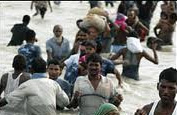Glacial Lake Outburst Flood

The acronym GLOF is used for glacier floods caused by the drainage of naturally dammed lakes in the glacier, on or at the margin of glaciers.
Glacial lakes form when a glacier retreats, leaving the debris mass at the end of the glacier – the end moraine – exposed.
The moraine wall can act as a natural dam, trapping the meltwater from the glacier and leading to the formation of a lake. The moraine dams are composed of unconsolidated boulders, gravel, sand, and silt. As with landslide dams, they can eventually break catastrophically, leading to a glacial lake outburst flood or GLOF.
The climatic change/variability in recent decades has made considerable impacts on the glacier lifecycle in the Himalayan region. As a result, many big glaciers melted rapidly, forming a large number of glacial lakes. Such lakes are inherently unstable and can be subject to catastrophic drainage, which is a potential source of danger to people and property in the valleys below them.
These result in serious death tolls and destruction of valuable natural resources, such as forests, farms, and costly mountain infrastructures. The Hindu Kush-Himalayan region has suffered several GLOF events originating from numerous glacial lakes, some of which have trans-boundary impacts.
In its history, Nepal has experienced several Glacial Lake Outburst Floods originating from numerous glacial lakes, some of which are even based outside its territory.
Many floods in Nepal have originated in Tibet and similarly, floods from Nepal do not respect national boundaries and have the potential to run into India and even Bangladesh.
Fourteen GLOF events have been recorded in Nepal, and another ten events where the outburst occurred in Tibet (China) but affected downstream communities in Nepal. On 11 July 1981, an outburst flood from the Zhangzangbo glacial lake in China caused extensive damage up to 50 km downstream into Nepal.
Although other natural disasters such as rainfall floods, earthquakes, landslides or wildfires have claimed the lives of thousands of Nepalis in recent decades, glacial lake outbursts are feared for the potential devastation from a single large event
The GLOF event of 4th August 1985 from Dig Tsho glacial lake in Eastern Nepal, in a valley next to Mount Everest, had especially brought about awareness of potentially dangerous glacial lakes in the high Himalayas, nationally and internationally.
An ice avalanche impacted the lake and generated a wave about 5 m high which overtopped the moraine dam. The lake, roughly measuring 1500 by 300m at a depth of 18m drained almost completely within 4-6 hours. The flood destroyed bridges, homes, agricultural land and the nearly completed Namche Small Hydropower Plant, two weeks before its inauguration, which resulted in an estimated loss of US$ 1.5 million. Remarkably, only 4-5 people lost their lives in the flood itself because a Sherpa festival was in progress and few people were walking the trails at the time.
Altogether some 1466 glacial lakes were identified in Nepal in a desk study using remote sensing data carried out in 2009; six of these were considered to be potentially dangerous. The outburst of such lakes depends upon the physical characteristic of the dam, the size and depth of the lake, and its surroundings. As glacial lakes are increasing and expanding rapidly, the issues of GLOF risk assessment, early warning systems, and mitigation measures to reduce the impact have becoming ever more important.
Among the identified critical lakes is the Tsho Rolpa Lake. Tsho Rolpa is the lake of superlatives: in the Nepal Himalayas it is the largest moraine-dammed proglacial lake, the most studied and known as the most dangerous glacial lake. Situated at an elevation of 4,580 metres above sea level, it is fed by the Tradkarding glacier, which is retreating at a rate of over 20 metres, and in some years within the last decade even 100 metres a year
Equally, glacial lakes are an important potential natural resource for water supply, which has yet to be effectively investigated. Glacial lakes may offer considerable benefits to local community. They can provide a natural storage facility for water as water supplies becoming increasingly scarce, they are a focus for tourist activities, and they often have a high cultural significance. Thus they need to be looked after and managed in a controlled way that reduces any threat while helping the potential benefits to be realised.
Related Content
- Report on action taken by the Govt on the observations/recommendations contained in 23rd report on glacier management in the country – monitoring of glaciers/glacial lakes including glacial lake outbursts leading to flash floods in the Himalayan region
- Twenty third report on glacier management in the country-monitoring of glaciers/lakes including glacial lake outbursts leading to flash-floods in the Himalayan region
- Review of water and climate change policies in South Asia
- Country's 1st climate change study centre in Bengaluru completes a decade
- GLOFs in the WOS: bibliometrics, geographies and global trends of research of glacial lake outburst floods (Web of Science, 1979–2016)
- Integrated context analysis (ICA): On vulnerability to food insecurity and natural hazards- Pakistan, 2017
